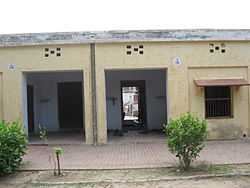Dayalbagh
Dayalbagh or Dayal Bagh (Hindi: दयाल बाग़, Urdu: دیال باغ) means 'Garden' (bagh) of 'Mercy' (daya), inferring "Garden of the Merciful Lord", is a locality in metropolitan Agra in western Uttar Pradesh, India. It is the headquarters of the Radhasoami faith, where the 8th revered leader (Sant Satguru) lives and presides over the satsang (holy service).
It is a self-sustained colony, where its inhabitants lead an active, disciplined and co-operative community life, conforming to the spiritual ideals of their faith. It has affiliated educational institutes such as the Dayalbagh Educational Institute.
History
The colony of Dayalbagh was founded on the Basant Day (translation: first day of spring) in 1915 by Huzur Sahabji Maharaj, the Fifth Revered Leader of Radhasoami Faith, as an ashram or a spiritual home for the followers of the faith, by planting a mulberry tree.
Community life
The colony is laid out in an open garden setting. The land where the colony was established once consisted of sand dunes. For more than 60 years residents of the colony - men and women, young and old - have worked with quiet dedication in a vast programme for reclamation of land launched in 1943 by Huzur Mehtaji Maharaj, the sixth Revered Leader of the Faith. The result is a lush green 1,200-acre (4.9 km2) farm where food-grains, oil-seeds, fodder, and vegetables are grown.

No individual owns property in Dayalbagh, as the land, houses and institutions belong to the community. People live and work as a community. For example, the residents share various responsibilities like cleaning up the colony and arranging night security. The colony has its own water supply, electricity distribution, and civic services. The colony's dairy provides most of the milk that is needed, and a community kitchen that supplies food at a very nominal cost (no-profit, no-loss basis) to pilgrims. The residents can also obtain meals from there and free themselves from household chores.

Health care
There is a hospital with a maternity ward. Facilities exist for ophthalmic and dental treatment, ultrasound, ECG, and pathological and X-Ray testing. All consultations and treatment are free for everyone. The majority of patients are from outside Dayalbagh. There are also homeopathic and ayurvedic dispensaries.
Industries
Small-scale industries known as the Model Industries were established in 1916 to provide employment and a source of livelihood to the persons residing in the colony. It has done some pioneering work in the country. The industries have now been decentralized and cottage scale production of goods of daily necessity is taking place in units set up by Satsangis all over the country.
The Radhasoami Urban Cooperative Bank and the Dayalbagh Mahila Bank cater to the financial requirements of various organizations and individuals in the colony. The Dayalbagh Printing Press prints Holy Books and the two Satsang weeklies, one in English (also available in its e-version) and the other in Hindi.

The day in Dayalbagh begins with congregational prayers, followed by physical fitness exercise and work on the farms and in colony by way of service, where after people go to their respective vocations. The day ends with prayers in the evening.
Demographics
As of the 2001 India census,[1] Dayalbagh had a population of 3324. Males constitute 51% of the population and females 49%. In Dayalbagh, 8% of the population is under 6 years of age.
Dayalbagh Educational Institute
The foundation of a school was laid the very next day after the foundation of the colony. The school has grown in course of time to become a Deemed University-Dayalbagh Educational Institute-with various faculties with facilities for research. The education system followed is unique and provides value-based multi-disciplinary education with work experience. In addition, the colony has a diploma level Technical College, a Women's Polytechnic, a nursery, primary level schools and secondary level colleges for boys and girls; a school of Languages; a School of Art and Culture; a Tailoring School; a School of Dress Designing and Interior Decoration; a Day Boarding School; a Training Center for Indian Music; and a Leather Working School.
Other non-university institutions
The community is organized through 11 Regional Associations in the country and three Associations abroad comprising over 500 Branches and Centers. There are several schools and dispensaries being run in different parts of the country and intensive tribal welfare and uplift work is being done in district Harda of Madhya Pradesh.
- Radhasoami High School, Timarni, Madhya Pradesh
- Schools in Rajaborari Estate, Madhya Pradesh
- Radhasoami Adivasi Primary School, Rajaborari
- Radhasoami Adivasi Primary School, Temrubahar
- Radhasoami Adivasi Primary School, Kachnar
- Radhasoami Adivasi Primary School, Kairi
- Radhasoami Adivasi Higher Secondary School, Rajaborari
- Radhasoami Adivasi Primary School, Mahagaon
- Radhasoami Adivasi Primary School, Salai
- Radhasoami Adivasi Primary School, Gulardhana
- Radhasoami Adivasi Primary School, Mogradhana
- Radhasoami Adivasi Primary School, Dabri
- Radhasoami Free Aided Elementary School, Kakinada, Andhra Pradesh
- Radhasoami Primary School, Melathiruvengadanathpuram, Tamil Nadu
- Madurai Primary School, Madurai, Tamil Nadu
- Soami Nagar Pre-Primary School, New Delhi
- Roorkee Model School, Roorkee, Uttaranchal
- New Model School, Daudhar, Punjab
- Chandigarh New Model School, Chandigarh
- Model Primary School, Dhariwal, Punjab
- Prem Nagar New Model School, Ludhiana, Punjab
- Soami Nagar Model School, Delhi
- Mullanpur New Model School, Mullanpur, Punjab
- Radhasoami Boys Primary School, Timarni, Madhya Pradesh
- Radhasoami School, Murar Bihar
- Satsang Training Employment and Rural Uplift Institute, Murar, Bihar
- Vocational Training Centres for Adivasi and Other Weaker Sections in Timarni and Rajaborari, Madhya Pradesh
Other colonies in Dayalbagh suburb of Agra
New residential colonies have developed around Dayalbagh, such as, Adan Bagh, Sarla Bagh, Heera Bagh, Kabir Nagar etc. The residents of these new colonies follow religions of their choice and not necessarily Radha Soami faith.
References
- ↑ "Census of India 2001: Data from the 2001 Census, including cities, villages and towns (Provisional)". Census Commission of India. Archived from the original on 2004-06-16. Retrieved 2008-11-01.
Coordinates: 27°13′27″N 78°00′48″E / 27.22417°N 78.01333°E